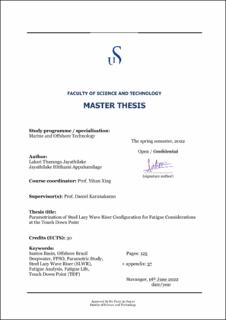| dc.description.abstract | With the advancement of technologies, deepwater oil and gas exploration has shown promising results worldwide. Production risers are integral in offshore hydrocarbon exploration because they transfer oil and gas from the subsea wells to the topsides. Steel Catenary Riser (SCR) is a favourable riser solution for deepwater developments due to its low cost and less complexity in implementation. With the increasing water depths and large floater motions, SCR has raised major concerns about fatigue performance at the touch down zone (TDZ). This can be solved by introducing buoyancy modules to the SCR, forming the Steel Lazy Wave Riser (SLWR) configuration. SLWR has shown better fatigue performance near the TDZ due to their ability to decouple vessel motion from TDZ.
The initial phase of the thesis presents static, dynamic and fatigue analysis and design of an SLWR connected to a Floating Production and Storage and Offloading (FPSO) vessel in 2000m water depth in Santos basin in Offshore Brazil. The riser has an internal diameter of 254mm and a wall thickness of 25mm and is made of API 5L X65 Carbon steel with a coating thickness of 70mm. Analyses are performed using OrcaFlex software, and the design is based on Load Resistance Factor Design (LRFD) guidelines as per DNV-OS-F201: Dynamic Risers.
The latter part of the thesis presents the parametric study on fatigue life near the Touch Down Point (TDP) for different SLWR configurations. Four different water depths (1500m, 2000m, 2500m, 3000m) and two different coating thicknesses (70mm: production riser, 3mm: injection riser) are considered, creating eight different scenarios. Each scenario considers 25 different SLWR configurations by changing the riser’s wave height (DB: distance between sag bend and hog bend) and distance from sag bend to the seabed (DS). In total, 200 different SLWR configurations are analysed during the research. Results show that fatigue life always increases with the increase of DB value irrespective of the DS value, water depth and coating thickness. In contrast, increasing the DS value does not always yield high fatigue life, and the rate of fatigue life change is marginal.
Keywords: Santos Basin, Offshore Brazil, Deepwater, FPSO, Steel Lazy Wave Riser (SLWR), Parametric Study, Fatigue Analysis, Fatigue Life, Touch Down Point (TDP) | |
